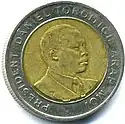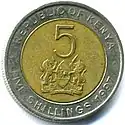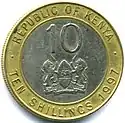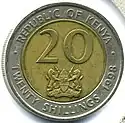| Shilingi ya Kenya (Swahili) | |
|---|---|
 10/= coin | |
| ISO 4217 | |
| Code | KES (numeric: 404) |
| Subunit | 0.01 |
| Denominations | |
| Subunit | |
| 1⁄100 | cent |
| Banknotes | |
| Freq. used | 50/=, 100/=, 200/=, 500/=, 1,000/= |
| Coins | |
| Freq. used | 1/=, 5/=, 10/=, 20/= |
| Demographics | |
| User(s) | Kenya |
| Issuance | |
| Central bank | Central Bank of Kenya |
| Website | www |
| Valuation | |
| Inflation | 5.1% |
| Source | Kenya National Bureau of Statistics, as of June 2010. |
The shilling (Swahili: shilingi; abbreviation: KSh; ISO code: KES) is the currency of Kenya. It is divided into 100 cents.
Notation
Prices in the Kenyan shilling are written in the form of x/y, where x is the amount in shillings, while y is the amount in cents. An equals sign or hyphen represents zero amount. For example, 50 cents is written as "-/50" and 100 shillings as "100/=" or "100/-". Sometimes the abbreviation KSh is prefixed for distinction. If the amount is written using words as well as numerals, only the prefix is used (e.g. KSh 10 million).
This pattern was modelled on sterling's pre-decimal notation, in which amounts were written in some combination of pounds (£), shillings (s), and pence (d, for denarius). In that notation, amounts under a pound were notated only in shillings and pence.
History
The Kenyan shilling replaced the East African shilling in 1966 at par.
Coins
| 10 cents (1980). | |
|---|---|
.jpg.webp) | |
| Obverse: Bust of Daniel arap Moi with lettering "PRESIDENT OF REPUBLIC OF KENYA DANIEL TOROITICH ARAP MOI". | Reverse: Face-value, year, Coat of arms of Kenya and country name. |
The first coins were issued in 1966 in denominations of -/5, -/10, -/25 and -/50, and 1/= and 2/=; -/25 coins were not minted after 1969 (except in the 1973 set); 2/= coins were last minted in 1971 (except in the 1973 set). In 1973 and 1985, 5/= coins were introduced, followed by 10/= in 1994 and 20/= in 1998.
Between 1967 and 1978, the portrait of Jomo Kenyatta, the first president of Kenya, originally appeared on the obverse of all of independent Kenya's coins. In 1980, a portrait of Daniel arap Moi replaced Kenyatta until 2005, when the central bank introduced a new coin series that restored the portrait of Kenyatta. The coins are -/50 and 1/= in stainless steel and bi-metallic coins of 5/=, 10/= and 20/=. A bi-metallic 40/= coin with the portrait of then-President Mwai Kibaki was issued in 2003 to commemorate the fortieth anniversary of Kenyan independence (1963).[1]
 5/= coin – obverse
5/= coin – obverse 5/= coin – reverse
5/= coin – reverse 10/= coin
10/= coin 20/= coin
20/= coin 40/= commemorative coin
40/= commemorative coin
New coins with the image of Kenyatta were issued in 2005. In 2010, Section 231(4) of the 2010 Constitution of Kenya stated "Notes and coins issued by the Central Bank of Kenya may bear images that depict or symbolise Kenya or an aspect of Kenya but may not bear the portrait of any individual." New banknotes and coins were scheduled to be released by 2018 to meet up with this new law.[2] A new series of coins was issued on 11 December 2018, in denominations of 1/=, 5/=, 10/= and 20/=. All of the coins depict the national Coat of arms of Kenya on the obverse and images of Africa's recognisable animals on the reverse.[3] The new series of coins is designed to be more recognisable for visually impaired people.[4]
| Coins of the Kenyan shilling (2018 issues) | |||||||
|---|---|---|---|---|---|---|---|
| Image | Value | Technical parameters | Description | ||||
| Diameter | Mass | Composition | Edge | Obverse | Reverse | ||
| 1/= | 23.9 mm | 5.5 grams | Nickel-plated steel | Segmented (Plain and Reeded sections) | Coat of arms of Kenya; text "Republic of Kenya" in English and Swahili | Giraffe; denomination in English and Swahili | |
| 5/= | 19.5 mm | 3.75 grams | Bi-metallic coin (Brass-plated steel center plug with a Nickel-plated steel outer ring) | Reeded | Coat of arms of Kenya; text "Republic of Kenya" in English and Swahili | Rhinoceros; denomination in English and Swahili | |
| 10/= | 23 mm | 5 grams | Bi-metallic coin (Nickel-plated steel center plug with a Brass-plated steel outer ring) | Reeded | Coat of arms of Kenya; text "Republic of Kenya" in English and Swahili | Lion; denomination in English and Swahili | |
| 20/= | 26 mm | 9 grams | Bi-metallic coin (Brass-plated steel center plug with a Nickel-plated steel outer ring) | Segmented (Plain and Reeded sections) | Coat of arms of Kenya; text "Republic of Kenya" in English and Swahili | Elephant; denomination in English and Swahili | |
Banknotes
On 14 September 1966, the Kenyan shilling replaced the East African shilling at par, although the latter was not demonetised until 1969. The Central Bank of Kenya issued notes in denominations of 5/=, 10/=, 20/=, 50/= and 100/=. All of the notes feature a portrait of Kenya's first prime minister and president, Jomo Kenyatta, on the front and diverse economic activities on the back.[5]
5/= notes were replaced by coins in 1985, with the same happening to 10/= and 20/= in 1994 and 1998. In 1986, 200/= notes were introduced, followed by 500/= in 1988 and 1,000/= in 1994.
As with the coins, Kenyatta appeared on the banknotes issued until 1978, with Daniel arap Moi's portrait replacing him in 1980. In 2003, after Mwai Kibaki replaced Moi as president, 5/=, 10/=, and 20/= notes from the 1978 series with Kenyatta's picture that had been in storage were issued, and circulated for a time. A new series of notes was then introduced on which Kenyatta reappeared in denominations of 50/=, 100/=, 200/=, 500/= and 1,000/=. The issue of the 200/= banknote dated 12 December 2003 commemorates the "40 years of Independence 1963–2003". The banknotes are printed in Nairobi by security printer De La Rue.
On 31 May 2019, the Central Bank of Kenya issued a new family of banknotes without the portraits of known Kenyan individuals, as mandated by the Constitution of Kenya of 2010. At the same time, the Central Bank of Kenya has withdrawn all previous versions of the 1,000/= banknote. These remained legal tender until 1 October 2019. All of the banknotes for this series share a common design of the Kenyatta International Convention Centre on the front side of the notes, and the back side of the notes feature images showcasing the richness of the people and nature of Kenya: "Green Energy" (50/=), "Agriculture" (100/=), "Social Services" (200/=), "Tourism" (500/=) and "Governance" (1,000/=). All five denominations also embody each of the big five animals of Africa: the buffalo (50/=), the leopard (100/=), rhinoceros (200/=), the lion (500/=) and the elephant (1,000/=).[6][7]
| Banknotes of the Kenyan shilling (1996 "Arap Moi" issue) | ||||
|---|---|---|---|---|
| Image | Denomination | Obverse | Reverse | Watermark |
 |
20/= | President Daniel Toroitich arap Moi; Coat of arms of Kenya | Baton; Moi International sports complex, Nairobi, jogger | Lion's head |
| 50/= | President Daniel Toroitich arap Moi; Coat of arms of Kenya | Caravan; Elephant tusks monument in Moi Avenua (formerly Kilindini Road), Mombasa | Lion's head | |
| 100/= | President Daniel Toroitich arap Moi; Coat of arms of Kenya | Monument to the 25th anniversary of independence, Nairobi | Lion's head | |
| 200/= | President Daniel Toroitich arap Moi; Coat of arms of Kenya | Unity monument, Nairobi | Lion's head | |
| 500/= | President Daniel Toroitich arap Moi; Coat of arms of Kenya | Parliament building, Nairobi | Lion's head | |
| 1,000/= | President Daniel Toroitich arap Moi; Coat of arms of Kenya | Elephants | Lion's head | |
| Banknotes of the Kenyan shilling (2004 "Jomo Kenyatta" issue (to be withdrawn from circulation)) | ||||
|---|---|---|---|---|
| Image | Denomination | Obverse | Reverse | Watermark |
| 50/= | President Jomo Kenyatta; Coat of arms of Kenya | Caravan; Elephant tusks monument in Moi Avenue (formerly Kilindini Road), Mombasa | Lion's head and electrotype 50 | |
| 100/= | President Jomo Kenyatta; Coat of arms of Kenya | Kenyatta statue; tower | Lion's head and electrotype 100 | |
| 200/= | President Jomo Kenyatta; Coat of arms of Kenya | Cotton harvest | Lion's head and electrotype 200 | |
| 500/= | President Jomo Kenyatta; Coat of arms of Kenya | Parliament building, Nairobi | Lion's head and electrotype 500 | |
| 1,000/= | President Jomo Kenyatta; Coat of arms of Kenya | Elephants | Lion's head and electrotype 1000 | |
| Banknotes of the Kenyan shilling (2019 issue (current issue)) | ||||||
|---|---|---|---|---|---|---|
| Front Image | Reverse Image | Denomination | Main Colour | Obverse | Reverse | Watermark |
| 50/= | Red | Coat of arms of Kenya; Statue of President Jomo Kenyatta; Kenyatta International Convention Centre; Buffalo | "Green Energy" (Wind Power, geothermal power, solar power) | Lion's head and electrotype 50 | ||
| 100/= | Violet | Coat of arms of Kenya; Statue of President Jomo Kenyatta; Kenyatta International Convention Centre; Leopard | "Agriculture" (Cereal, agriculture, livestock) | Lion's head and electrotype 100 | ||
| 200/= | Blue | Coat of arms of Kenya; Statue of President Jomo Kenyatta; Kenyatta International Convention Centre; Rhinoceros | "Social Services" (Health services, Education, sports) | Lion's head and electrotype 200 | ||
| 500/= | Green | Coat of arms of Kenya; Statue of President Jomo Kenyatta; Kenyatta International Convention Centre; Lion | "Tourism" (Wildlife; Lion) | Lion's head and electrotype 500 | ||
| 1000/= | Brown | Coat of arms of Kenya; Statue of President Jomo Kenyatta; Kenyatta International Convention Centre; Elephant | "Governance" (Parliament building, Nairobi) | Lion's head and electrotype 1000 | ||
Exchange rate
The current exchange rate is readily obtainable from services such as those in the table below:
| Current KES exchange rates | |
|---|---|
| From Google Finance: | AUD CAD CHF CNY EUR GBP HKD JPY USD |
| From Yahoo! Finance: | AUD CAD CHF CNY EUR GBP HKD JPY USD |
| From XE.com: | AUD CAD CHF CNY EUR GBP HKD JPY USD |
| From OANDA: | AUD CAD CHF CNY EUR GBP HKD JPY USD |
See also
References
- ↑ "Supplement No. 100". The Kenya Gazette. Republic of Kenya. CV (122): 2681. 11 December 2003.
- ↑ The Constitution of Kenya of 2010; Section 231(4) on the Central Bank of Kenya World Intellectual Property Organization (www.wipo.int). Retrieved 2013-09-27.
- ↑ Kenya: New circulation coin series introduced by president, Coin Update (news.coinupdate.com). 27 December 2018. Retrieved 2018-12-28.
- ↑ "Kenya makes coins accessible for the visually impaired". 11 May 2019.
- ↑ Linzmayer, Owen (2012). "Kenya". The Banknote Book. San Francisco, CA: BanknoteNews.com.
- ↑ "Central Bank unveils new generation banknotes to curb fraud". Capital News Kenya. 1 June 2019.
- ↑ "New Generation Banknotes Pamphlet" (PDF). Central Bank of Kenya. 1 June 2019.
External links
| Preceded by: East African shilling Reason: currency independence Ratio: at par Note: independent shilling introduced in 1966, but EA shilling not demonetised until 1969 |
Currency of Kenya 1966 – |
Succeeded by: Current |
.svg.png.webp)